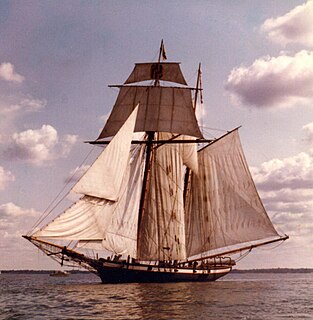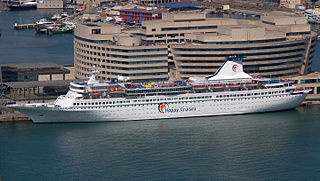
A clipper was a type of mid-19th-century merchant sailing vessel, designed for speed. Clippers were generally narrow for their length, small by later 19th century standards, could carry limited bulk freight, and had a large total sail area. "Clipper" does not refer to a specific sailplan; clippers may be schooners, brigs, brigantines, etc., as well as full-rigged ships. Clippers were mostly constructed in British and American shipyards, though France, Brazil, the Netherlands and other nations also produced some. Clippers sailed all over the world, primarily on the trade routes between the United Kingdom and China, in transatlantic trade, and on the New York-to-San Francisco route around Cape Horn during the California Gold Rush. Dutch clippers were built beginning in the 1850s for the tea trade and passenger service to Java.

Royal Clipper is a steel-hulled five-masted fully rigged tall ship used as a cruise ship. She was redesigned by Robert McFarlane of McFarlane ShipDesign, for Star Clippers Ltd. of Sweden, the same designer behind the cruise company's first two vessels. This third one was built using an existing steel hull designed by Zygmunt Choreń that was modified by the Gdańsk Shipyard, where 24 metres (79 ft) was added to its length.

Iron-hulled sailing ships represented the final evolution of sailing ships at the end of the age of sail. They were built to carry bulk cargo for long distances in the nineteenth and early twentieth centuries. They were the largest of merchant sailing ships, with three to five masts and square sails, as well as other sail plans. They carried lumber, guano, grain or ore between continents. Later examples had steel hulls. They are sometimes referred to as "windjammers" or "tall ships". Several survive, variously operating as school ships, museum ships, restaurant ships, and cruise ships.

The Pride of Baltimore was a reproduction of a typical early 19th-century "Baltimore clipper" topsail schooner, a style of vessel made famous by its success as a privateer commerce raider and small but nimble warship in the War of 1812 (1812–1815), against British merchant shipping and a vastly superior world-wide British Royal Navy. After the end of the war, Baltimore Clippers did not have sufficient cargo carrying capacity for normal merchant trade, so some were used in the illegal opium trade into China and vessels of the same type were used in the transatlantic slave trade from Africa.

A Baltimore Clipper is a fast sailing ship historically built on the mid-Atlantic seaboard of the United States of America, especially at the port of Baltimore, Maryland. An early form of clipper, the name is most commonly applied to two-masted schooners and brigantines. These vessels may also be referred to as Baltimore Flyers.

MS Song of Norway was one of the first ships purpose-built as a cruise ship. She was the first ship of Royal Caribbean International when she entered operation in 1970. She was sold for scrap in 2013 and broken up in 2014, after serving her last years as a gambling ship.

Star Flyer is a four masted barquentine built as a cruise ship, and operated by Star Clippers Ltd of Sweden. A luxury vessel, Star Flyer is a sister ship to Star Clipper. Both sailed under the Luxembourg flag until 2010, and now sail under the Maltese flag.

Stag Hound was launched on December 7, 1850 in East Boston, Massachusetts. Designed by shipbuilder Donald McKay for the California trade, she was briefly the largest merchant ship in the world. She was in active service from 1851 until her total loss in 1861.

Surprise was a California clipper built in East Boston in 1850. It initially rounded Cape Horn to California, but the vessel's owners, A. A. Low & Brother, soon found that the vessel performed well in Far Eastern waters. From that point onward the vessel spent much of her working life in the China trade, although the vessel also made three trips from the East Coast of the United States to California.

Carrier Dove was an 1855 medium clipper. She was one of two well-known clippers launched in Baltimore that year, the other being Mary Whitridge.

Race Horse was an 1850 clipper barque. She set a record of 109 days from New York to San Francisco during the first Clipper Race around the Horn.
An extreme clipper was a clipper designed to sacrifice cargo capacity for speed. They had a bow lengthened above the water, a drawing out and sharpening of the forward body, and the greatest breadth further aft. In the United States, extreme clippers were built in the period 1845 to 1855. British-built extreme clippers include vessels built over the period 1854 to 1870.

Cimba was a British-built clipper in the Australian wool trade. She sailed between London and Sydney for 20 years, from 1878 to 1898. In 1905, Cimba set the sailing ship record for a passage from Callao to Iquique, of 14 days.

Lahloo was a British tea clipper known for winning the Tea Race of 1870, and finishing second in the Tea Race of 1871. She sailed from Foochow to London with over a million pounds of tea in 1868.

Lord of the Isles was the first iron-hulled tea clipper, built in Greenock in 1853. She served in the tea trade until 1862, and also made voyages to Australia. She is known for a record passage between Greenock and Shanghai, and for her close finish in the 1856 Tea Race from China to England, docking in London just ten minutes before Maury. This race was the basis for the plot of a 1927 movie by Cecil B. DeMille The Yankee Clipper.
Eamont was an opium clipper built in Cowes. It was the subject of an 1891 book, A cruise in an opium clipper, by Captain Lindsay Anderson.

Shooting Star was an extreme clipper built in 1851 near Boston, in Medford, Massachusetts. She was the first "real clipper" to be built in Medford, and sailed in the San Francisco, China, and Far East trades. According to Howe and Matthews, she was known as "one of the fastest of the small clippers".

SV Golden Horizon is a steel-hulled five-masted barque rigged tall ship which is intended to be used as a cruise ship. Originally named Flying Clipper, the luxury vessel was designed by Polish naval architect Zygmunt Choreń, for Star Clippers Ltd. of Sweden, and built by the Brodosplit Shipyard in Split, Croatia. She is the largest sailing ship ever launched. Her design was based on France II, a famous French five-mast cargo windjammer built in 1911.
Kaisow, a composite clipper, was built by Robert Steele & Company at Greenock and launched on 19 November 1868.

















